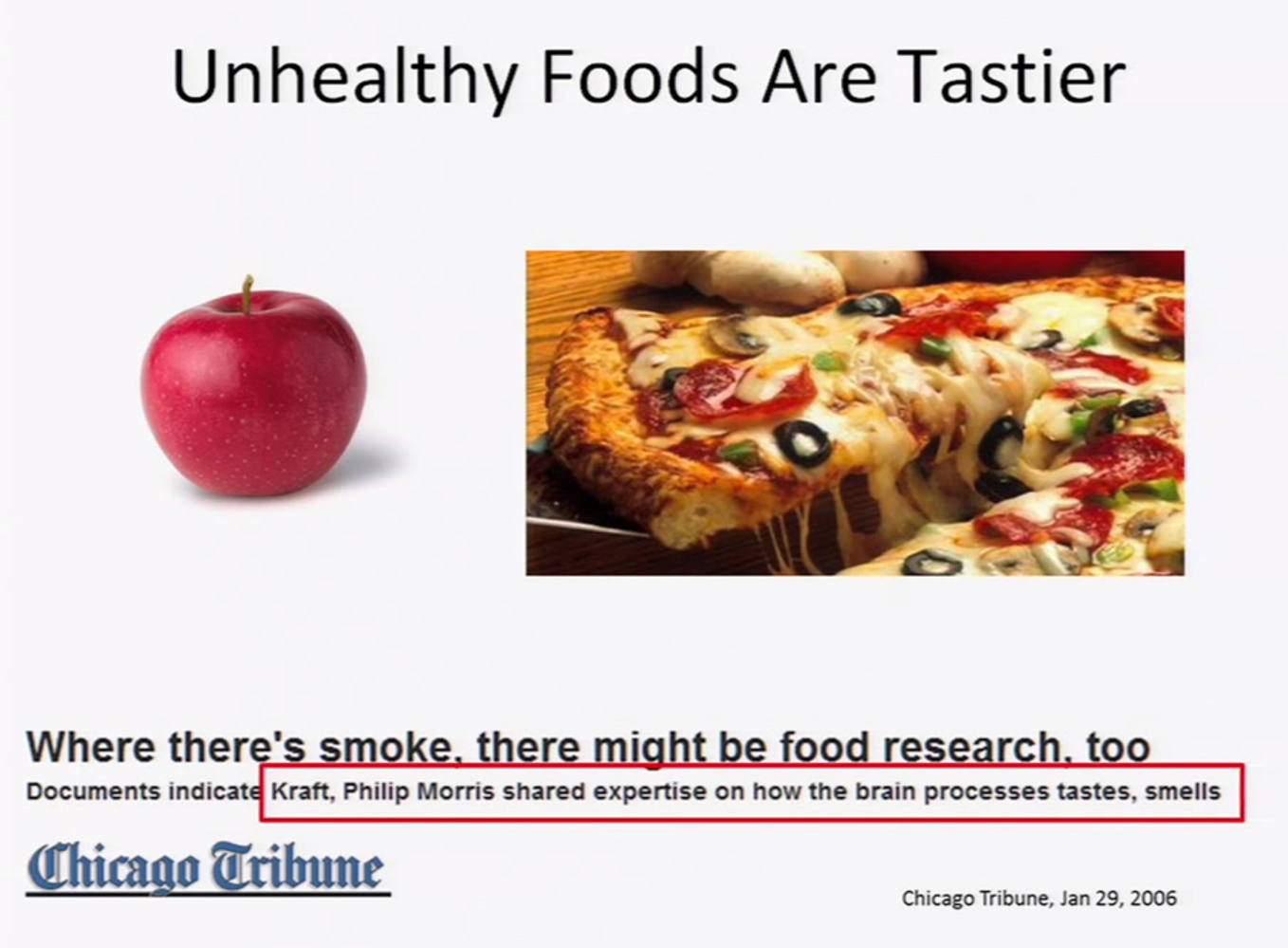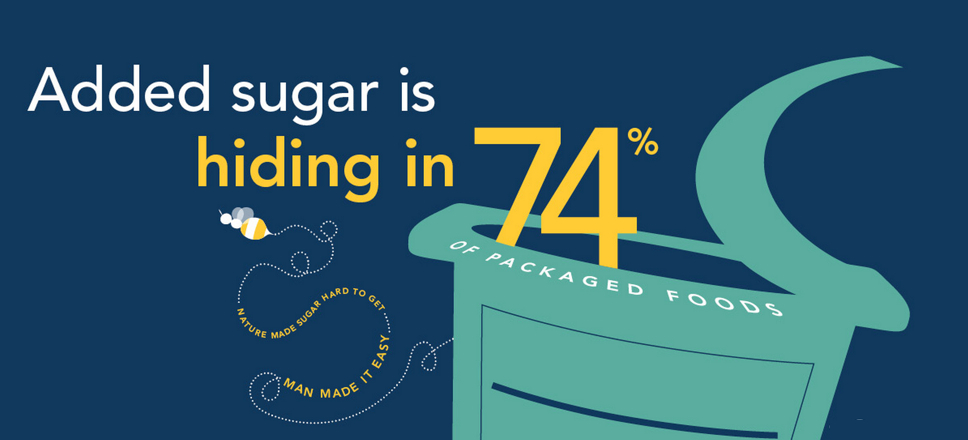|
![]()
| Unhealthier foods are engineered to be tastier Why1 #370365 Food scientists have become adept at understanding how our brains respond to, and react to, and crave tastes, smells and textures, and have become adept at engineering and processing foods to take advantage of that – largely by adding lots of salt, sugar and fat – and to make these foods almost irresistible to our brains. | 
Sources: Scott Kahan, Chicago Tribune (2006) - Although in theory minimal processing of foods can improve nutritional content, in practice most processing is done so to increase palatability, shelf-life, and transportability (and these processes tend to reduce nutritional quality). [2]

|
+Citaten (3) - CitatenVoeg citaat toeList by: CiterankMapLink[1] Why we eat the way we eat
Citerend uit: Scott Kahan
Publication info: 2011 June, 3
Geciteerd door: David Price 10:14 AM 17 December 2014 GMT
Citerank: (15) 352388Advertising and marketing reinforce new eating patterns Marketing and advertising instil and reinforce new cultural norms about what (e.g. fast food) and how to eat (e.g. snacking), and how much (e.g. larger portions) to eat.555CD992, 352390Industrial way of life is obesogenicRapid societal changes—for example, in food production, motorised transport and work/home lifestyle patterns—have placed human physiology (which has evolved to cope with an under-supply of food and high energy expenditure) under new stresses, and revealed an underlying genetic tendency to accumulate and conserve energy (i.e. gain weight) in a high proportion of the population. In this sense, obesity can be construed as a normal physiological response to an abnormal environment.555CD992, 368175Targeting advertising at childrenAdvertising and other marketing approaches are targeted at children and other vulnerable groups.62C78C9A, 370363Unhealthy foods are cheaper and getting cheaper555CD992, 370364Portions have grown larger555CD992, 370366Ready-to-eat food is more readily availableReady-to-eat food is increasingly available in industrial societies 24-hours a day and in places where food wasn't traditionally available (such as pharmacies and petrol stations), as well as via the growing number of fast food restaurants and coffee shops.555CD992, 371727Growth in restaurants and dining outThe restaurant industry has almost doubled its share of every dollar spent on food in the United States over the last 60 years from 25% in 1955 to 47% today. Much of this growth reflects the expansion in fast food restaurants (a trend observed in other countries including the UK).648CC79C, 399889Industrial way of life is obesogenicRapid societal changes—for example, in food production, motorised transport and work/home lifestyle patterns—have placed human physiology (which has evolved to cope with an under-supply of food and high energy expenditure) under new stresses, and revealed an underlying genetic tendency to accumulate and conserve energy (i.e. gain weight) in a high proportion of the population. In this sense, obesity can be construed as a normal physiological response to an abnormal environment.555CD992, 399917Advertising and marketing reinforce new eating patterns Marketing and advertising instil and reinforce new cultural norms about what (e.g. fast food) and how to eat (e.g. snacking), and how much (e.g. larger portions) to eat.555CD992, 399918Unhealthy foods are cheaper and getting cheaper555CD992, 399919Portions have grown larger555CD992, 399920Unhealthier foods are engineered to be tastierFood scientists have become adept at understanding how our brains respond to, and react to, and crave tastes, smells and textures, and have become adept at engineering and processing foods to take advantage of that – largely by adding lots of salt, sugar and fat – and to make these foods almost irresistible to our brains.555CD992, 399921Ready-to-eat food is more readily availableReady-to-eat food is increasingly available in industrial societies 24-hours a day and in places where food wasn't traditionally available (such as pharmacies and petrol stations), as well as via the growing number of fast food restaurants and coffee shops.555CD992, 399945Targeting advertising at childrenAdvertising and other marketing approaches are targeted at children and other vulnerable groups.62C78C9A, 399947Growth in restaurants and dining outThe restaurant industry has almost doubled its share of every dollar spent on food in the United States over the last 60 years from 25% in 1955 to 47% today. Much of this growth reflects the expansion in fast food restaurants (a trend observed in other countries including the UK).648CC79C URL: |
Link[2] Response of the Food and Beverage Industry to the Obesity Threat
Citerend uit: Jeffrey P. Koplan, Kelly D. Brownell
Publication info: 2010 October, 6, AMA. 2010;304(13):1487-1488. doi:10.1001/jama.2010.1436
Geciteerd door: David Price 2:41 PM 21 December 2014 GMT
Citerank: (18) 351043Public health interventions are often resistedEvidence suggests that, for example, some food and beverage companies are adopting similar tactics to those adopted earlier by the tobacco companies to avoid public health interventions (such as taxation and regulation) that might threaten their profits.555CD992, 351052Corporate interests are often in tension with public health interestSelf-regulatory measures often struggle to accomplish sufficient public health impact, as corporate financial interests are often in tension with the public health interest.13EF597B, 368180Resisting public health interventionsEvidence suggests that some food and beverage companies are adopting similar tactics to those adopted earlier by the tobacco companies to avoid public health interventions (such as taxation and regulation) that might threaten their profits.555CD992, 368618Place onus of proof on industryThe onus should be on companies to demonstrate rigorously and independently that the self-regulatory measures and/or private–public partnerships are improving public health as well as private profit. Where this is found to be case, the specific methods should be extended and replicated.565CA4D9, 371073Self-regulation and public-private partnerships have worked beforeIndustry self-regulation and public-private partnerships have worked successfully in the public interest in a number of cases.1198CE71, 371074Self-regulation in the forestry and fisheries industries62C78C9A, 371075Pharmaceutical company drug donationsDonations by pharmaceutical companies of mectizan for river blindness, mebendazole to eliminate intestinal parasites, and azithromycin to treat trachoma have supported health agencies and benefited millions of persons with debilitating diseases – and illustrate who public-private partnerships can also promote health.62C78C9A, 371077Folate fortification of flour and bread productsFolate fortification of flour and bread products to help reduce rates of neural tube defects is an example of the way in which public-private collaborations with the food industry can boost public health.62C78C9A, 371078Shaping public understanding and scientific researchWell-resourced food companies are able to recruit leading nutritional scientist, experts and researchers to guide and justify product development, reformulation and health impact. Research suggests that studies funded by industry are 4- to 8-fold more likely to support conclusions favourable to the industry.555CD992, 399703Corporate interests are often in tension with public health interestSelf-regulatory measures often struggle to accomplish sufficient public health impact, as corporate financial interests are often in tension with the public health interest.13EF597B, 399709Place onus of proof on industryThe onus should be on companies to demonstrate rigorously and independently that the self-regulatory measures and/or private–public partnerships are improving public health as well as private profit. Where this is found to be case, the specific methods should be extended and replicated.565CA4D9, 399710Self-regulation and public-private partnerships have worked beforeIndustry self-regulation and public-private partnerships have worked successfully in the public interest in a number of cases.1198CE71, 399788Self-regulation in the forestry and fisheries industries62C78C9A, 399789Pharmaceutical company drug donationsDonations by pharmaceutical companies of mectizan for river blindness, mebendazole to eliminate intestinal parasites, and azithromycin to treat trachoma have supported health agencies and benefited millions of persons with debilitating diseases – and illustrate who public-private partnerships can also promote health.62C78C9A, 399790Folate fortification of flour and bread productsFolate fortification of flour and bread products to help reduce rates of neural tube defects is an example of the way in which public-private collaborations with the food industry can boost public health.62C78C9A, 399894Public health interventions are often resistedEvidence suggests that, for example, some food and beverage companies are adopting similar tactics to those adopted earlier by the tobacco companies to avoid public health interventions (such as taxation and regulation) that might threaten their profits.555CD992, 399916Shaping public understanding and scientific researchWell-resourced food companies are able to recruit leading nutritional scientist, experts and researchers to guide and justify product development, reformulation and health impact. Research suggests that studies funded by industry are 4- to 8-fold more likely to support conclusions favourable to the industry.555CD992, 399920Unhealthier foods are engineered to be tastierFood scientists have become adept at understanding how our brains respond to, and react to, and crave tastes, smells and textures, and have become adept at engineering and processing foods to take advantage of that – largely by adding lots of salt, sugar and fat – and to make these foods almost irresistible to our brains.555CD992 URL:
|
Link[3] Hidden in Plain Sight: added sugar is hiding in 74% of packaged foods
Citerend uit: SugarScience.org
Geciteerd door: David Price 0:36 AM 4 January 2015 GMT
Citerank: (1) 399920Unhealthier foods are engineered to be tastierFood scientists have become adept at understanding how our brains respond to, and react to, and crave tastes, smells and textures, and have become adept at engineering and processing foods to take advantage of that – largely by adding lots of salt, sugar and fat – and to make these foods almost irresistible to our brains.555CD992
URL:
| | Fragment- We tend to think that added sugar is mainly found in desserts like cookies and cakes, but it's also found in many savory foods, such as bread and pasta sauce. And some foods promoted as "natural" or "healthy" are laden with added sugars, compounding the confusion. In fact, manufacturers add sugar to 74% of packaged foods sold in supermarkets.1 So, even if you skip dessert, you may still be consuming more added sugar than is recommended. |
|
|